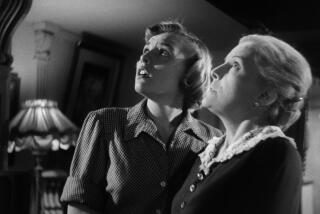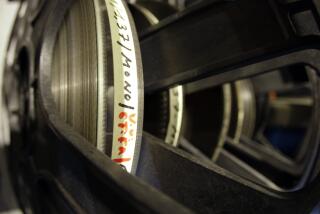Queen of the Silents Begins a New, Remastered Reign
- Share via
There really is something about Mary--Mary Pickford, that is--and it’s not just those famous curls.
Although she died 20 years ago, cinema’s first international superstar--who was married first to screen legend Douglas Fairbanks and later to actor-musician Charles “Buddy” Rodgers--is making a comeback in a big way. On Tuesday, Milestone Film & Video released six of her classic films, which have been remastered, tinted and outfitted with new scores.
This month also marks the publication of the lavish pictorial book “Mary Pickford Rediscovered: Rare Pictures of a Hollywood Legend,” written by film historian Kevin Brownlow with an introduction by Robert Cushman, a Pickford expert and curator of the Academy of Motion Picture Arts and Sciences’ Roddy McDowall Photographic Archive.
On Saturday, a three-month exhibition of more than 55 pictures from the book will open in the Grand Lobby of the academy’s headquarters in Beverly Hills. To kick off the exhibition, on Friday the academy will screen the 1919 comedy “The Hoodlum,” from a print made from material provided to the academy by the George Eastman House and the Pickford Foundation.
Hosted by Brownlow, the screening will feature live musical accompaniment by the Robert Israel Orchestra. That evening, the George Eastman House Archive will receive the academy’s Medal of Commendation for its work in film preservation.
Though Pickford was the No. 1 box-office star in America 15 out of 17 years during the silent era, contemporary filmgoers rarely have had a chance to see her films. They’ve generally only seen stills of Pickford in her golden ringlets playing young girls or entertaining at her Beverly Hills mansion, Pickfair.
But Pickford was much more than just “America’s Sweetheart.”
“There has been a prejudice [about her] built up over the years, partly because the films have been difficult to see,” says Brownlow, who fell under the spell of the actress after seeing “Hoodlum” in the 1950s.
“People do have this image of her ringlets from stills of her films of very fusty characters with absolutely no interest to a modern generation,” Brownlow explains. “Compare her to Louise Brooks [the silent screen star with a very modern sensibility] for the moment and you see the problem.”
Pickford, though, was a far more amazing, complex talent than Brooks. Besides acting, she also ran her own production company at age 22 and was still in her 20s when she cofounded United Artists.
“Her movies are exceptionally good, aren’t they?” says Brownlow. “They are beautifully made. While she did not direct her pictures, she was the one whom everybody deferred to. She was the one whom everyone wanted to please. She was the one who set the standards, and her standards were amazingly high, so technically her pictures lead the industry--hers and Fairbanks’.”
Milestone’s Dennis Doros says he believes that from 1915 to 1925, Pickford was the most influential filmmaker in the United States--”even more so than D.W. Griffith.”
“Her Marshall Neilan [-directed] films and other films are so advanced and so subtle, they stand up today as great works of art. ‘Stella Maris’ is one of the greatest films ever made. As a star, as producer and head of a studio, there had never been a woman compared to her.”
Pickford, Cushman contends, invented subtle, modern-day screen acting. “She had a sixth sense,” says Cushman. “It is largely forgotten that in the teens and throughout the ‘20s many critics kept saying she is the finest actress on screen.”
The six films Milestone is releasing ($30 each) are prime examples of Pickford at her best: “Amarilly of Clothesline Alley,” “Daddy Long Legs,” “My Best Girl,” “Stella Maris,” “Tess of the Storm Country” and “Sparrows.”
Milestone and the Mary Pickford Foundation selected these films to be released, Doros says, because not only do they spotlight her best performances in adult roles, but they also have not been seen in years.
“She had kept a lot of important films away” from release, says Doros. The reason, he adds, is that she had “an ego. She was terrified of being rejudged in these quaint silent films.”
“She was afraid of being laughed at,” adds Cushman, who began a long friendship with Pickford after writing a fan letter to her as a 14-year-old.
Still, Cushman says, she wanted to save her films from the ravages of time. She began donating her films to the Library of Congress and spent her own money for preservation.
“Mary Pickford Rediscovered,” which is published by the academy in association with Harry N. Abrams Inc., is the first major pictorial depicting her entire career. The pictures were culled from the Mary Pickford Collection at the academy’s Margaret Herrick Library.
* “The Hoodlum” screens Friday at 8 p.m. at the Samuel Goldwyn Theater at Academy of Motion Picture Arts and Sciences, 8949 Wilshire Blvd., Beverly Hills; $5. “Mary Pickford Rediscovered: Rare Pictures of a Hollywood Legend” in the Grand Lobby Gallery opens Saturday. Regular schedule: Tuesdays-Fridays, 10 a.m.-5 p.m.; Saturdays-Sundays, noon-6 p.m. Ends Aug. 1. Free. (310) 247-3600.
More to Read
Only good movies
Get the Indie Focus newsletter, Mark Olsen's weekly guide to the world of cinema.
You may occasionally receive promotional content from the Los Angeles Times.











